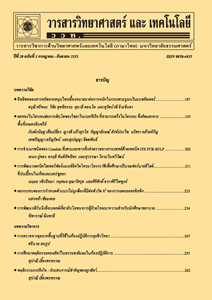การจำแนกหนอนแดงโดยเทคนิคทางชีวโมเลกุล
Main Article Content
Abstract
บทคัดย่อ
หนอนแดงพบแพร่กระจายอยู่ในแหล่งน้ำทั่วไป และนิยมใช้เป็นตัวบ่งชี้ทางชีววิทยาของแหล่งน้ำ แต่การศึกษาหนอนแดงที่สุ่มตัวอย่างจากแหล่งน้ำมีอุปสรรค เนื่องจากหนอนแดงบางสปีชีส์มีรูปร่างภายนอกคล้ายกันมาก และการจัดจำแนกแบบดั้งเดิมคือการดูจากรูปร่างภายนอกบางครั้งทำได้ยาก ในการศึกษานี้จึงใช้การจัดจำแนกโดยเทคนิคชีวโมเลกุล ได้แก่ การวิเคราะห์ลำดับนิวคลีโอไทด์ของยีน cytochrome c oxidase (COI) ควบคู่กับการดูจากลักษณะภายนอก ตัวอย่างหนอนแดงที่ศึกษาซื้อมาจากตลาดจตุรจักร กรุงเทพมหานคร พบว่าการเพิ่มปริมาณดีเอ็นเอด้วยวิธีพีซีอาร์จากตัวอย่างการศึกษานี้มีประสิทธิภาพต่ำ มีค่าเพียง 8.49 % และดีเอ็นเอมีคุณภาพดีเพียงพอที่จะนำไปวิเคราะห์ลำดับนิวคลีโอไทด์ได้มีเพียง 11 ตัวอย่าง การเปรียบเทียบลำดับนิวคลีโอไทด์พบว่ามี 3 สปีชีส์ ที่ได้ผลสอดคล้องกันทั้งสองฐานข้อมูล โดยมีสองสปีชีส์ที่แต่ละสปีชีส์ได้มาจาก 3 ตัวอย่าง และอีก 1 สปีชีส์ มาจาก 1 ตัวอย่าง ค่าความแตกต่างทางพันธุกรรมและดัชนีความเหมือนของแต่ละตัวอย่างภายในสปีชีส์เดียวกันยังได้ผลสอดคล้องกันทั้ง 2 สปีชีส์ สำหรับตัวอย่างอื่นไม่สามารถจำแนกได้ เนื่องจากผลการเปรียบเทียบลำดับนิวคลีโอไทด์จากสองฐานข้อมูลขัดแย้งกัน และขัดแย้งกับการจำแนกจากรูปร่างภายนอก
คำสำคัญ : หนอนแดง; ยีน cytochrome c oxidase; การจัดจำแนก; เทคนิคชีวโมเลกุล
Abstract
Chironomidae larvae are the widely distributed and frequently found invertebrate in inland water bodies. They are extensively used as bioindicators of freshwater ecosystem health. However; the uses of chironomids are limited due to their morphological similarity and difficulties in manual identifications. To overcome these problems; this study; therefore; used the sequence of mitochondrial COI gene; together with morphological traits; to identify DNA profiles of chironomid samples bought from Jatujak Market; Bangkok. Overall; only 8.49% amplification efficiency was received. Comparison of COI sequences with the two DNA databases resulted in the same closest species of the samples to three species; in which the two species was received from 3 samples whilst the third one was received from only one sample. In addition; congruence of genetic distances and similarity indexes were also observed among samples within the same species of these two species. Other chironomid larvae samples could not be identified because neither sequence comparisons resulted from the two DNA databases nor morphological identifications was concordant.
Keywords: Chironomidae; mitochondrial COI gene; molecular-based identification

